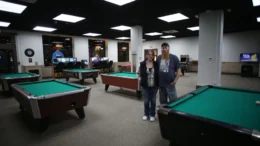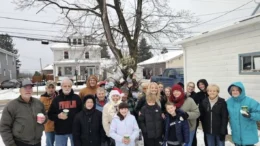Marissa Dechant Staff writer
The return of a television cold case series has brought back painful memories that 25 years later are still extant in local law enforcement officers who helped solve the murder of an Oil City girl.
“Cold Case Files,” the critically-acclaimed A&E Network show, is getting a reboot at 9 p.m. Monday after being off the air for nearly 10 years.
Producers of the show chose the 1992 murder of Shauna Howe to open the 10-episode season.
Nearly 12 years after the incident, police charged brothers James E. O’Brien, 32 at the time, and Timothy M. O’Brien, 37, with kidnapping, raping and murdering Shauna. They were convicted after a 2005 trial and received life sentences without the possibility of parole.
Eldred “Ted” Walker, 47 at the time of the arrests, was charged with kidnapping and murder in the case. He reached a plea agreement with prosecutors and was given a 40-year sentence in exchange for his testimony against the O’Briens.
Shauna’s disappearance and murder haunted the area as trick-or-treat hours were moved to the daytime when children would be safer. Nighttime hours were brought back in 2008.
“When we read about the Howe story we were immediately struck by the impact Shauna’s disappearance had on Oil City and particularly on Halloween — a night that is supposed to be fun for kids was turned into an annual reminder of an unspeakable tragedy,” said the producers of “Cold Case Files.”
Producers contacted Richard Graham, the second lead investigator on the case, and Lucy Howe-Brown, Shauna’s mother, over a year ago and were inspired by the extensive police work and fight for the truth of who Shauna’s killers were.
“We knew this story had to be an episode of ‘Cold Case Files,'” producers said.
What followed were three brief trips to Oil City from October through January to interview law enforcement and investigators who were involved in the case.
Film crews interviewed Graham and his wife and investigative partner, Betsy Ross; Franklin state police lead investigators Charles Daley and Brian O’Toole; and Oil City police chief Robert Wenner.
Howe-Brown and her husband Jon Brown, who now live in North Carolina, were also interviewed for the show.
Missteps by investigators
“I always thought Shauna’s story should be told,” said Graham, who agreed with Ross that they were hesitant to relive the case for cameras.
In the end, Graham said they chose to be interviewed in order to show how mistakes made by law enforcement can hinder a case.
The biggest misstep was believing the O’Briens were in jail during the time of Shauna’s abduction and murder, Graham said.
The brothers were well-known to law enforcement but were not pursued due to their assumed incarceration.
In 2001, Graham interviewed Timothy O’Brien who was in jail for the sexual assault of two children. Graham asked for a saliva sample for the Howe case and said Timothy O’Brien’s reaction seemed suspicious.
“A chill ran down my spine, and my mind began to race because of the way that he reacted,” Graham said. “It was then that I began to wonder if there had been a mistake made years ago that led all to feel that the O’Briens were incarcerated when Shauna was taken.”
Graham began to review the files for official reports of the brothers being incarcerated when Shauna was murdered. With the help of Meadville state police trooper Jon McClain, Graham discovered that the O’Briens were out of jail on bail at that time.
A DNA sample was then sought from James O’Brien, who had been in prison since 1995 for the assault and attempted kidnapping of a young woman.
A month later, a match was made linking James O’Brien to the semen found on Shauna’s body and clothing.
The number of offenders involved in the case also presented an issue for investigators.
It was originally thought that only one suspect had taken Shauna, so when Walker’s DNA excluded him from the crime, he was not pursued until later on.
In 1998, Graham sought the help of FBI criminal profiler Robert Ressler. Graham said Ressler convinced him that investigators should be seeking multiple offenders in the case.
Graham said he found it unusual that the O’Briens and Walker were able to keep quiet for over a decade.
“What struck me most was that no one spoke out about the case, of all people involved,” he said.
Lessons learned
Shauna’s case brought on new challenges for local law enforcement, who had little experience with homicide investigations.
“I had prior minimal experience with investigating murder cases but nothing to this magnitude,” said O’Toole, the third and final lead investigator and arresting officer in the case.
O’Toole continues to work as a Franklin trooper
He said his regular work was put into perspective against Shauna’s murder.
“You can’t top this one. It was the worst of the worst,” O’Toole said. “You find out how evil people are.”
O’Toole graduated from the police academy in February 1992, and he wasn’t working at the Franklin barracks at the time of Shauna’s murder.
“It definitely showed me, with this case going on for such a long time, that you’re never done with an investigation. You don’t want to give up on something,” he said.
He also later arrested Nicholas Bowen, 17, in connection with the murder of 4-year-old Shenee Freeman in Oil City in 1997.
“We are certainly more prepared now as an agency,” Wenner said, adding that Oil City police applied what they learned from Shauna’s case and were able to make a quick arrest in the Freeman case.
Daley came onto the case near the end of his career as a Franklin state police trooper. He said it was difficult to leave but knew the case would be in good hands.
“There came a time when I had to make a decision to leave. The case wasn’t going to falter whether I was there or not. We had some tough investigators on the case,” Daley said.
Many investigators, in fact, thanked other officers and officials in their tireless search for Shauna’s killers.
O’Toole credited fellow trooper Vern Brown for his help in interviewing Walker on numerous occasions.
Graham thanked multiple state officers and Ressler, who, along with his criminal profiling of the case, acted as a mentor to Graham and Ross.
Graham said he had no prior experience with a missing child case before Shauna. He is now a representative for the National Center for Missing and Exploited Children.
After his retirement in 2002, he and Ross were hired as private investigators by Howe-Brown. They have since worked numerous cases.
Moving forward
Graham and Ross said they fear the area has forgotten about Shauna and that parents need to remain wary of their children going out alone.
Wenner said people must be aware that predators will take advantage of lax parenting.
“If you can’t see your children or don’t know where they’re at, you better make sure they’re with someone who does. There are people out there who are evil and will prey on our children,” Wenner said. “As a society, we are judged on how we protect our elderly and our children.”
O’Toole, who grew up near Howe-Brown in Tionesta, said the case hit home for him, and justice triumphed in the end.
He said people should not live in fear but should be mindful that even small towns can experience tragedy.
“You can’t let these things dictate your life, but you need to be aware that these things happen and can take place,” O’Toole said.


































